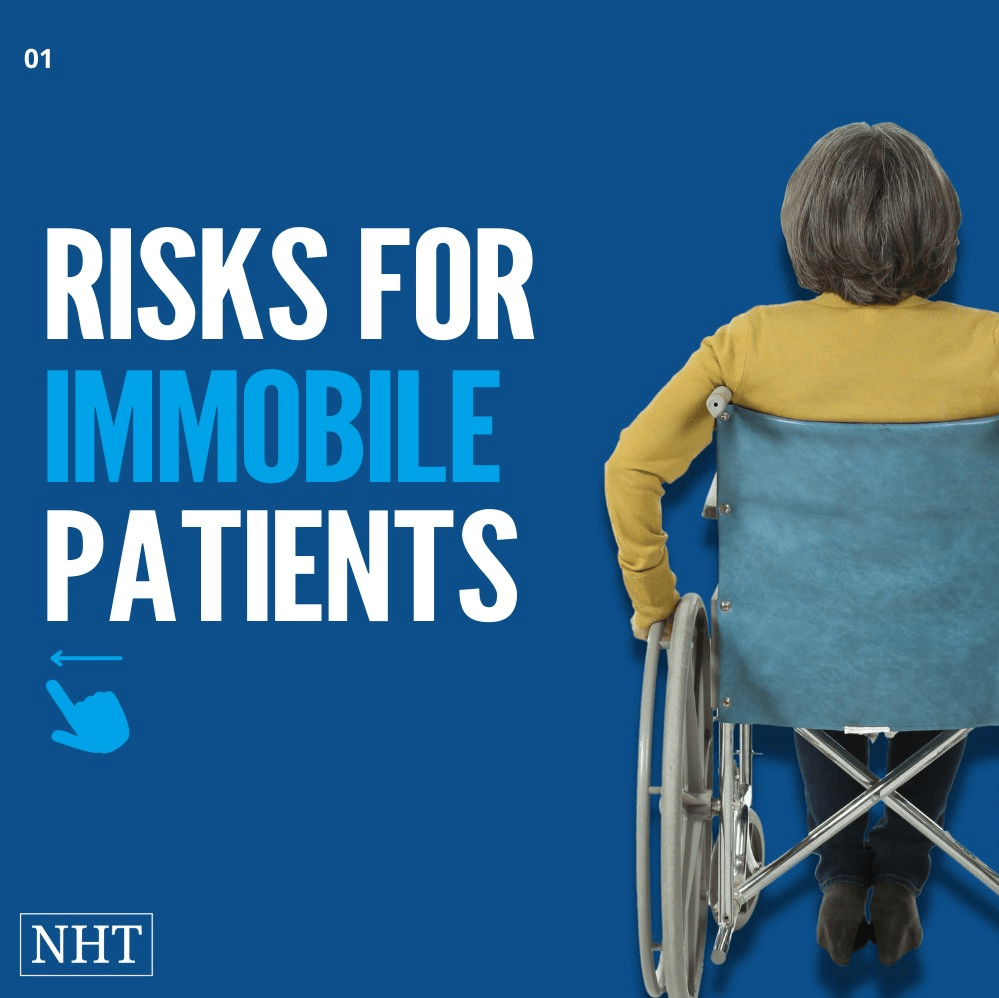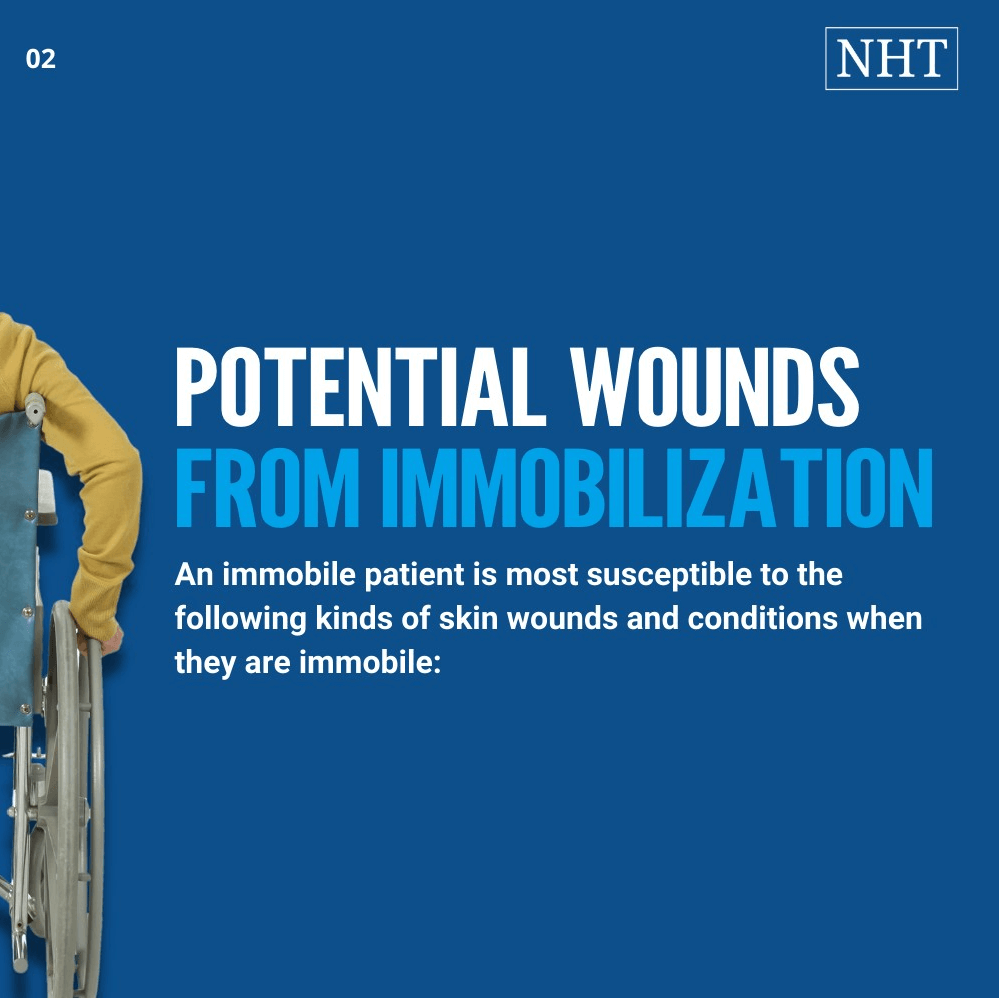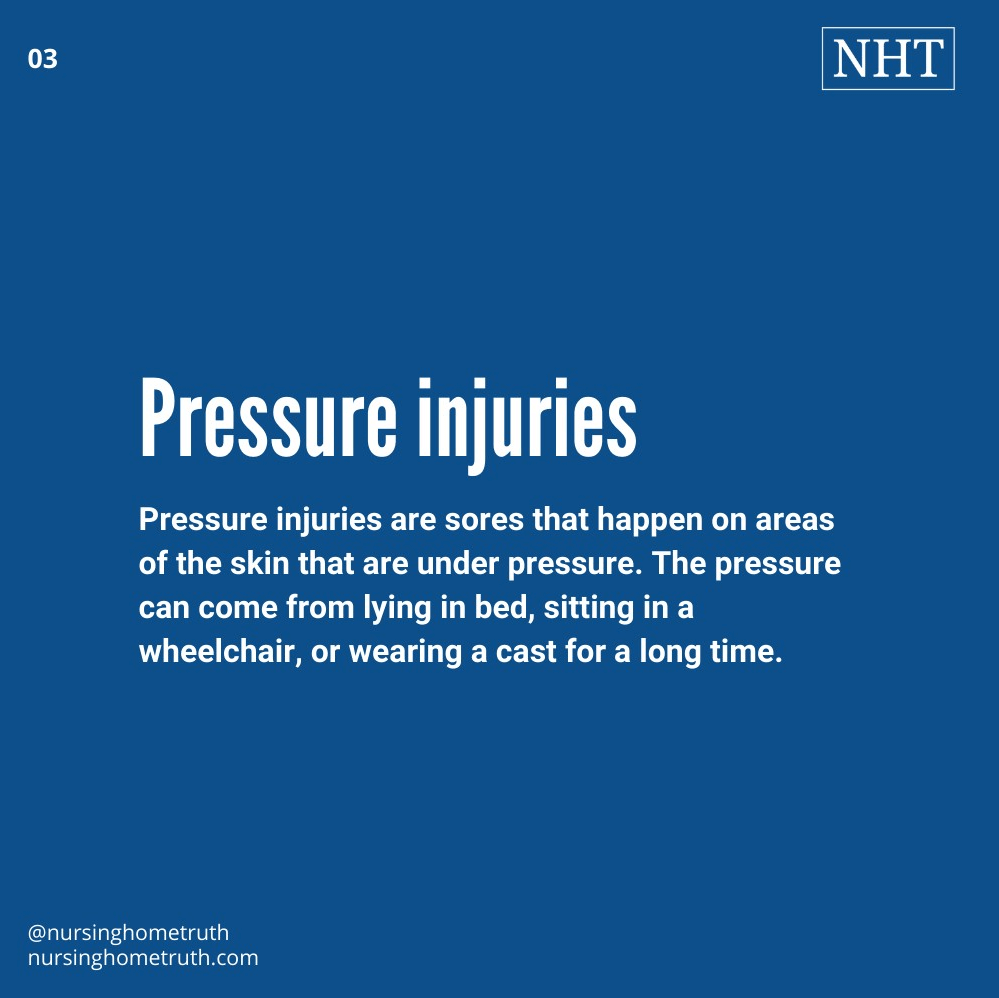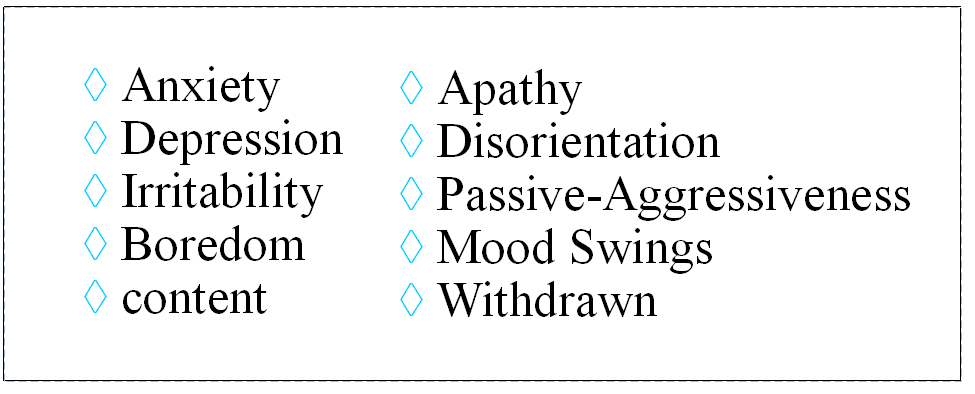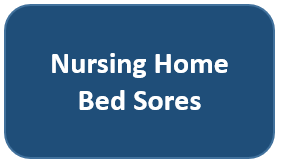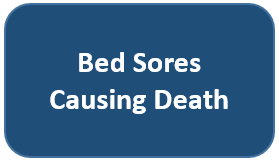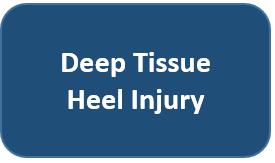Article Updated: November 14, 2023
Immobile Patients Are Most Susceptible to The Following Risks
Immobile patients are most susceptible to:
◊ Pressure wounds
◊ Muscle atrophy
◊ Weight loss
◊ Depression
◊ Medical neglect
You will learn the basics about each of these vulnerabilities below.
If you or someone you know suffered a different type of injury while being immobile or bed-bound, contact me for a free telephone consult about whether that injury is indicative of medical negligence.
Clickable Table of Contents
Susceptibility of Immobile Patients
1 – Immobile Patient is Susceptible to Wounds
2 – Immobile Patient is Susceptible to Weight Loss
3 – Immobile Patient is Susceptible to Atrophy
4 – Immobile Patient is Susceptible to Depression
5 – Immobile Patient is Susceptible to Neglect
Resources
6 – Protecting Immobile Patients
7 – Supporting Literature, Citations & Research
8 – About the Author
9 – Legal Help in Maryland & Nationally
Immobile Patient is Susceptible to Wounds
An immobile patient is most susceptible to the following kinds of skin wounds and conditions when they are immobile:
◊ Pressure injures
◊ Open wounds
◊ Cellulitis
The major reason for these skin afflictions is immobility. Immobility is the inability of an individual to access and use their body because of weakness in the muscles, broken or missing limbs, or disability.
Such conditions can come about because of injury, surgery, or in some cases the weakening can come about because of aging.
Wounds are a major concern for those who are immobile and when they are not cared for carefully, their conditions can deteriorate and cause serious injury or death.
Immobile Patient is Susceptible to Weight Loss
Immobile patients are also often at risk of excessive and unhealthy weigh loss. The reason for this is mainly steeped in the fact that a person who is bedridden or cannot move freely is reliant on other people for feedings.
A person who is immobile will lose tone in their skeletal muscles over time because the bones no longer bear any weight in a normal manner. The result of this is a serious reduction in muscle mass as they shrivel and dwindle from lack of use.
This loss of muscle tone loss and skeletal muscle weakening also causes the patient to lose strength every week which further increases the chances of further weight loss.
If this is also accompanied with any loss of fat, there will be weight loss that can alter the normal weight of an immobile individual and make them more susceptible to health concerns that come with weight loss.
Fat loss often does accompany this skeletal muscle tone loss as the immobile individual will often have an inadequate intake of needed nutrients leading to weight loss.
Immobile Patient is Susceptible to Muscle Atrophy
When an individual does not move for a long period of time, not only do they lose muscle strength and tone, they also develop a stiffening of their muscles.
Atrophy and contracture both occur often in those who are immobile for an extended period of time.
When the muscle mass starts to reduce and waste away, the affected area begins to reduce in size and shrivel making it harder to use these muscles in the future.
A common occurrence that comes at the same time in the body is a contracture, where the body starts to not only lose mass and get smaller but also the muscles tighten and become stiff.
Contracture starts to develop in as short as 4 days and range of motion starts to get lost in 14-15 days.
Elderly patients are at a much higher risk of these conditions as there are higher rates of them being immobile and spending long periods of time in nursing homes and hospitals.
Immobile Patient is Susceptible to Depression
Patients who are immobile are at high risk of emotional, psychological and nervous system problems. Loss of independence and change in lifestyle results in the individual being faced with a whole new direction and reality which can be hard to deal with and adjust to.
These adjustments require changes in almost all parts of life, ranging from eating habits, socialization and even sleep patterns.
An immobile patient is most susceptible to the following emotional and psychological conditions:
These conditions arise from a lack of simulation and the overall social isolation that a person goes through.
The change in body image and feeling helpless and hopeless also add to the increased risk of depression.
Sleep schedules also change as individuals are often not able to sleep at night and change their sleeping patterns.
Even this small change can cause a person to be unable to participate in normal daily activities as they sleep during the day more.
Immobile Patient is Susceptible to Neglect
Immobile Patients & Neglect
An individual who is immobile will rely on others for most if not all of their daily activities.
When there is reliance on others for daily tasks, the rate of abuse increases and the rate of neglect increases as well.
Extended immobility is related to the development of many chronic health conditions which arise from neglect when a person is not given the level attention they require.
This neglect causes otherwise preventable conditions like UTIs and open wounds on the skin to get worse and not get treated in an adequate manner.
Nurses Ignore Immobile Patients
This is by far the most common problem in nursing homes. Busy nurses decide that they can ignore and abandon an immobile patient because, well, what is the immobile patient going to do about it?
Such patients typically have major health issues, including dementia, Alzheimer’s, or other issues that leave them incapable of reporting the neglect and abuse.
Busy nurses skip these patients as a form of corner cutting, thinking, “nobody will ever know.”
Protecting Immobile Patients
If a nursing home resident who was bed-bound or immobile suffered a serious injury, it is almost always because the medical facility did something wrong. Plain and simple.
I’ve reviewed and investigated hundreds of these cases and the story is always the same: the facility did less for the immobile patient because of the fact the patient was immobile and the facility thought they could get away with cutting this corner.
The irony in this negligence is that immobile patients need MORE help, not LESS.
If you would like me to conduct an investigation into why an immobile patient was injured, I invite you to contact me.
I live and breath to hold negligent medical facilities accountable for their bad acts. I am here for you.
Warmly,
Reza Davani, Esq.
State Bar No.: #1212110211
Federal Bar No.: #30168
Cellphone: (301) 922-4598
Email: reza@nursinghometruth.com
Pressure Ulcer Legal Library
Click/Tap Icons to Access Articles

Supporting Literature, Citations & Resources:
Calderbank, R. (2000). Abuse and disabled people: vulnerability or social indifference?. Disability & Society, 15(3), 521-534.
Pro, H. C. (2012). Complications from Immobility by Body System.
Kotschet, K., Johnson, W., McGregor, S., Kettlewell, J., Kyoong, A., O’Driscoll, D. M., … & Horne, M. K. (2014). Daytime sleep in Parkinson’s disease measured by episodes of immobility. Parkinsonism & related disorders, 20(6), 578-583.
Ikezoe, T., Mori, N., Nakamura, M., & Ichihashi, N. (2011). Age-related muscle atrophy in the lower extremities and daily physical activity in elderly women. Archives of gerontology and geriatrics, 53(2), e153-e157.
Suetta, C., Frandsen, U., Mackey, A. L., Jensen, L., Hvid, L. G., Bayer, M. L., … & Kjaer, M. (2013). Ageing is associated with diminished muscle re‐growth and myogenic precursor cell expansion early after immobility‐induced atrophy in human skeletal muscle. The Journal of physiology, 591(15), 3789-3804.
About the Author
This nursing home and medical malpractice article was written by Baltimore, Maryland nursing home attorney Reza Davani, Esquire. Mr. Davani received his Juris Doctor degree from a Tier 1 law school, the University of Maryland Francs King Carey School of Law. He received his first license to practice law from the State of Maryland’s Court of Appeals (MD State License No. 1212110211), and just four months later received a federal law license from the United States District Court for the District of Maryland (Federal License No. 30168).
Mr. Davani has been practicing law for over 10 years. He began practicing law by helping clients as a sanctioned student lawyer before receiving his law license, and second chaired his first jury trial in federal court before even graduating law school. He is a registered member of the Maryland Association for Justice (MAJ), the American Bar Association (ABA), the American Association for Justice (AAJ), and was formerly on the MAJ’s Legislative Leader’s Circle.
Mr. Davani has taken over 20 cases to trial in state and federal court, and favorably settled well over 100 cases for injured victims. He has personally helped his clients recover over $25,000,000 in personal injury, medical malpractice, and nursing home abuse settlements and verdicts in Maryland and other states. He is dedicated to fighting for justice, and welcomes the opportunity to help you.
About the Nurse Consultant
La kesha Dillard, started her nursing career in 1994 as a Home Health Aide (HHA). She enjoyed working with people so much that she earned her certification as a Certified Nursing Assistant (CNA). She attended Trocaire College and completed both (the LPN and RN) programs where she earned her LPN/RN AAS degree. She was motivated to further her education and in 2016 she received her baccalaureate degree in nursing from Daemen College Amherst, NY. In 2019 she successfully completed Chamberlain College of Nursing, Nurse Executive and Leadership program, and earned a Masters of Science in Nursing (MSN) degree.
Mrs. Dillard wanted to learn more about the business side of nursing, so she attended Devry University and received her Master of Business Administration (MBA) degree in 2023.
In 2021, she successfully completed the Vicky Millazo program where she earned her certification as a Legal Nurse consultant. She opened up her nurse consulting business in 2022 and is the proud owner, founder/CEO at Mrs. RN Consulting, LLC. La kesha has consulted and worked with many attorneys by helping them understand the medical records to get justice for their clients. She has worked at several Long-Term Care facilities (LTC), medical surge units and has several years of experience with patient care and consulting.
She is a strong advocate for patients and believes in Person-Centered Care (PCC) at all times. La kesha is also a tough upholder for staff rights, and she continues to motivate nurse entrepreneurs to further their education in nursing.
Medical Malpractice Nursing Home Abuse Lawyer Near You in Baltimore, Maryland & Beyond
I can help you anywhere in Maryland, including Allegany County, Anne Arundel County, Baltimore City, Baltimore County, Carroll County, Calvert County, Caroline County, Cecil County, Charles County, Dorchester County, Frederick County, Garrett County, Harford County, Howard County, Kent County, Montgomery County, Prince George’s County, Queen Anne’s County, Somerset County, St. Mary’s County, Talbot County, Washington County, Wicomico County, and Worcester County.
I have helped clients in over a dozen jurisdictions, including California, Delaware, District of Columbia, Georgia, Illinois, Iowa, Massachusetts, Maryland, Mississippi, New Jersey, New Mexico, New York, North Carolina, Pennsylvania, South Carolina, Washington, and Virginia.
I help injured victims nationwide in all 50 states on a case-by-case basis via Pro Hac Vice.



